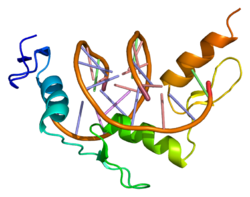Early growth response protein 2 is a protein that in humans is encoded by the EGR2 gene. EGR2 (also termed Krox20) is a transcription regulatory factor, containing three zinc finger DNA-binding sites, and is highly expressed in a population of migrating neural crest cells.[5][6][7] It is later expressed in the neural crest derived cells of the cranial ganglion. The protein encoded by Krox20 contains two cys2his2-type zinc fingers. Krox20 gene expression is restricted to the early hindbrain development.[6][8] It is evolutionarily conserved in vertebrates, humans, mice, chicks, and zebra fish.[9] In addition, the amino acid sequence and most aspects of the embryonic gene pattern is conserved among vertebrates, further implicating its role in hindbrain development.[7][10][11][12] When the Krox20 is deleted in mice, the protein coding ability of the Krox20 gene (including the DNA-binding domain of the zinc finger) is diminished. These mice are unable to survive after birth and exhibit major hindbrain defects.[6][8] These defects include but are not limited to defects in formation of cranial sensory ganglia, partial fusion of the trigeminal nerve (V) with the facial (VII) and auditory (VII) nerves, the proximal nerve roots coming off of these ganglia were disorganized and intertwined among one another as they entered the brainstem, and there was fusion of the glossopharyngeal (IX) nerve complex.[13][14][15]
- ^ a b c GRCh38: Ensembl release 89: ENSG00000122877 – Ensembl, May 2017
- ^ a b c GRCm38: Ensembl release 89: ENSMUSG00000037868 – Ensembl, May 2017
- ^ "Human PubMed Reference:". National Center for Biotechnology Information, U.S. National Library of Medicine.
- ^ "Mouse PubMed Reference:". National Center for Biotechnology Information, U.S. National Library of Medicine.
- ^ Cite error: The named reference
Chavrier_1989was invoked but never defined (see the help page). - ^ a b c Cite error: The named reference
Swiatek_1993was invoked but never defined (see the help page). - ^ a b Cite error: The named reference
Wilkinson_1989awas invoked but never defined (see the help page). - ^ a b Cite error: The named reference
Bradley_1993was invoked but never defined (see the help page). - ^ Cite error: The named reference
Bhat_1992was invoked but never defined (see the help page). - ^ Cite error: The named reference
Wilkinson_1989bwas invoked but never defined (see the help page). - ^ Cite error: The named reference
Hunt_1991was invoked but never defined (see the help page). - ^ Cite error: The named reference
Oxtoby_1993was invoked but never defined (see the help page). - ^ Cite error: The named reference
Frohman_1990was invoked but never defined (see the help page). - ^ Cite error: The named reference
Murphy_1989was invoked but never defined (see the help page). - ^ Cite error: The named reference
Nieto_1991was invoked but never defined (see the help page).





